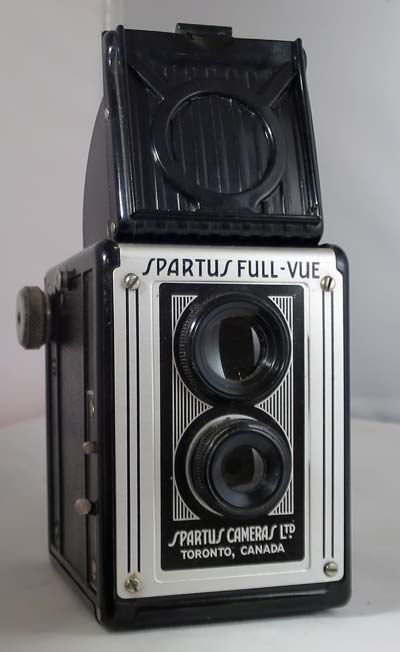Spartus Full-Vue
Specification

| Manufacturer | : | Spartus |
|---|---|---|
| Produced | : | 1948 |
| Classification | : | Medium Format |
| Body Type | : | Pseudo Twin Lens Reflex |
| Construction | : | Bakelite |
| Film Type | : | 120 |
| Film Width | : | 62mm |
| ImageSize | : | 2¼ x 2¼ in |
| No. of Images | : | 12 |
| Lens Type | : | Meniscus |
| Focus Type | : | Fixed |
| Focal Length | : | 95mm |
| Focal Range | : | 8ft - inf. |
| Aperture Type | : | fixed |
| Aperture | : | f/18 |
| Shutter Type | : | Rotary |
| Shutter Speeds | : | T, I*(1/40s) |
| Size Open(w x h x d) | : | 92 x 173 x 112 mm |
| Size Closed(w x h x d) | : | 92 x 124 x 112 mm |
| Weight | : | 481g |
| * Measured on this camera | ||
Art Deco Credentials
![]()
![]()
![]()
Noteworthy: Worth giving special attention
- Produced after the main Art Deco period.
- Moulded Bakelite body.
- Double ribs on each side of body.
- Body embossed to look like leather
- Geometric pattern on viewfinder cover.
- Multi-line geometric pattern in silver and black on face plate.
- Art Deco font on front panel.
Description
This simple Spartus Full-Vue pseudo TLR was made from 1948 to 1960 by American manufacturer Spartus. This model exposes twelve 6 x 6 cm square images on 120 film. The lens of its viewfinder is larger in diameter than its taking lens, giving a bright finder image on the hooded matte screen. Spartus used various metal face-plate designs and plastic moldings over the production period. Early examples were made of Bakelite, although later models may have been other plastics. This model has a thermoset plastic body (Bakelite) but the viewfinder cover is a softer non-thermoset plastic. The Falcon Magni-Vue is a very similar camera but precedes the Spartus Full-Vue.
The shutter is a simple Instant/Time type and there is no aperture adjustment possible. The twin-lens reflex provides a 4 x 4cm sized image on a ground glass viewer. It is fitted with a fixed focus lens. It is usually held at waist level to compose the image. There is a certain amount of parallax error for close-up subjects. It does not have a tripod socket. In 1949 it was improved with a synchronized flash.
How to Use
Find the manual for the flash version of this camera here:- https://www.cameramanuals.org/pdf_files/spartus_full-vue_reflex.pdf
This camera takes 120 film which is easily available from photographic outlets.
As the shutter speed is only 1/40s, it is advisable to hold it against a wall or other solid object. For quick snapshots, hold it firmly against your body.
If you don't want to bother with an exposure meter, follow the guide shown. It is based on the 'Sunny 16' rule. Film is so forgiving and will produce acceptable results even when overexposed by 2 or 3 stops or underexposed by 1 stop.
The tables assume that the sun is at least 30 degrees above the horizon - that's 10am - 5pm on a summers day (May - August) in the UK.
Remember that the exposure guide in the manual may not be helpful as it is based on the use of old film with a low ISO value.
Using ISO 100/125 film - shutter speed 1/40s
| Weather Conditions | Shadow Detail | Aperture | Exposure |
|---|---|---|---|
 Sunny SunnySnow/Sand | Dark with sharp edges | f/18 | +2 Stops Overexposed Acceptable |
 Sunny Sunny | Distinct | f/18 | +1 Stop Overexposed Acceptable |
 Slight Overcast Slight Overcast | Soft around edges | f/18 | Good |
 Overcast Overcast | Barely visible | f/18 | -1 Stop Underexposed Acceptable |
 Heavy Overcast Heavy Overcast | None | f/18 | -2 Stops Underexposed Not Acceptable |
 Open Shade Open Shade/Sunset | None | f/18 | -3 Stops Underexposed Not Acceptable |